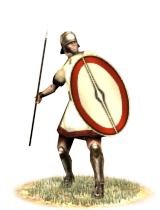Difference between revisions of "Heavy Peltasts (RTW Unit)"
m (→Overview) |
m (→Details) |
||
| Line 29: | Line 29: | ||
== Details == | == Details == | ||
| − | Heavy Peltasts are the | + | Heavy Peltasts are statistically one of the stronger skirmishers in the game. They are like Roman Velites, but with more armour and defense skill and large shields. Their durability allows them to defeat other skirmishers easily in both ranged duels and melee, as they take a lot less casualties from return javelin fire. Their durability should not be overestimated, however. They are still very vulnerable to cavalry and have no real chance against any dedicated infantry in a melee either, although they will at least survive longer against them. Use them like Peltasts but don’t hesitate to charge into flanks or into weak enemy units to support an allied unit. You should use more of them too, because unlike most skirmishers this one is actually useful. Their upkeep is the same as the normal Peltasts, despite these ones being a much better unit. |
| + | |||
| + | Unfortunately, Heavy Peltasts require a Catapult Range to be recruited. This is a big disadvantage and it makes them a late game unit; despite not being strong enough to stand against later armies. In many cases it is better to simply stick with the earlier and longer ranged Archers. On the other hand though, they are cheap to recruit and maintain. They can also be useful in Multiplayer battles, where their building requirements are irrelevant. | ||
== Factions == | == Factions == | ||
Latest revision as of 14:41, 16 May 2022
![]() A combination of protection and mobility make heavy peltasts suitable for skirmishing duties as well as for taking a stand as part of the main battle line.
A combination of protection and mobility make heavy peltasts suitable for skirmishing duties as well as for taking a stand as part of the main battle line.
Overview
Heavy peltasts are skirmishers, but carry large oval shields into battle. This added protection makes them suitable for standing in the main battle line, as well as for flanking and screening duties.\n\n Their javelins are intended to thin the ranks of approaching troops, weakening their morale just before battle is joined. They also carry short swords for when they are asked to engage in close combat. A heavy peltast’s shield (the thureos), is made from wood covered in leather. While this confers reasonable protection, when confronted with heavy infantry or practically any form of cavalry, these troops should not be expected to stand for long. Like other peltasts, this unit is well suited to using ambush tactics.
Details
Heavy Peltasts are statistically one of the stronger skirmishers in the game. They are like Roman Velites, but with more armour and defense skill and large shields. Their durability allows them to defeat other skirmishers easily in both ranged duels and melee, as they take a lot less casualties from return javelin fire. Their durability should not be overestimated, however. They are still very vulnerable to cavalry and have no real chance against any dedicated infantry in a melee either, although they will at least survive longer against them. Use them like Peltasts but don’t hesitate to charge into flanks or into weak enemy units to support an allied unit. You should use more of them too, because unlike most skirmishers this one is actually useful. Their upkeep is the same as the normal Peltasts, despite these ones being a much better unit.
Unfortunately, Heavy Peltasts require a Catapult Range to be recruited. This is a big disadvantage and it makes them a late game unit; despite not being strong enough to stand against later armies. In many cases it is better to simply stick with the earlier and longer ranged Archers. On the other hand though, they are cheap to recruit and maintain. They can also be useful in Multiplayer battles, where their building requirements are irrelevant.
